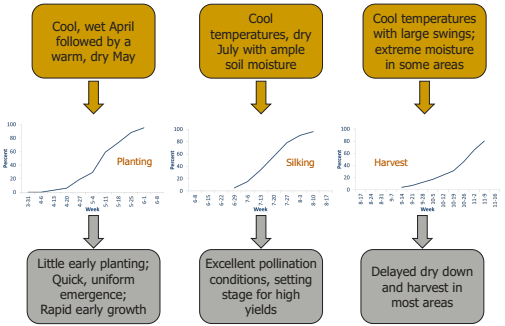IV. CROP AND WEATHER CONDITIONS
HIGHLIGHTS
Weather plays a large role in the corn planting process, growing conditions, and grain development in the field, which, in turn, impacts final grain yield and quality. Overall, 2014 was a cool, wet year with delayed planting and delayed harvest. However, the crop was quite uniform in maturity and had the best crop condition rating during reproductive growth in the past ten years, with record harvests expected. The following highlights the key events of the 2014 growing season:
- A cold, wet spring prevented early planting, but warm May soils led to uniform emergence.
- Excellent pollination conditions then cool summer temperatures with ample rainfall encouraged starch and oil accumulation in more kernels, with less protein concentration.
- Pollination conditions were favorable for high yield, but also for Diplodia in some locations.
- Cool temperatures and flooding delayed maturity and harvesting, especially in the northern areas.
- An early freeze affecting 20% of the corn growing area, leading to some kernel immaturity, which with delayed harvest may have led to more drying and possible corn stress cracks.
The following sections describe how the 2014 growing season weather impacted the corn yield and grain quality in the U.S. Corn Belt.
1The U.S. Department of Agriculture (USDA) rates the U.S. corn crop weekly during the production cycle. The rating is based on yield potential, and plant stress due to a number of factors including extreme temperatures, excessive or insufficient moisture, disease, insect damage and/or weed pressure.
